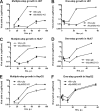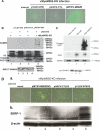M062 is a host range factor essential for myxoma virus pathogenesis and functions as an antagonist of host SAMD9 in human cells
- PMID: 21248034
- PMCID: PMC3067850
- DOI: 10.1128/JVI.02243-10
M062 is a host range factor essential for myxoma virus pathogenesis and functions as an antagonist of host SAMD9 in human cells
Abstract
Myxoma virus (MYXV) M062R is a functional homolog of the C7L family of host range genes from orthopoxviruses. We constructed a targeted M062R-knockout-MYXV (vMyxM062-KO) and characterized its properties in vitro and in vivo. In European rabbits, infection by vMyxM062-KO was completely asymptomatic. The surviving rabbits did not gain full protection against the subsequent lethal-dose challenge with wild-type MYXV. We also looked for cellular tropism defects in a variety of cultured cells. In all of the rabbit cells tested, vMyxM062-KO conducts an abortive infection, although it initiates viral DNA replication. In many, but not all, human cancer cells that are permissive for wild-type MYXV, vMyxM062-KO exhibited a profound replication defect. We categorized human cells tested into two groups: (i) type A, which support productive replication for wild-type MYXV but are unable to produce significant levels of progeny virus by vMyxM062-KO, and (ii) type B, which are permissive to infections by both wild-type MYXV and vMyxM062-KO. Furthermore, using proteomic strategies, we identified sterile α motif domain containing 9 (SAMD9), an interferon-regulated cellular protein implicated in human inflammatory disorders, as a unique host binding partner of M062 in human cells. Significantly, knocking down SAMD9 in type A human cancer cells led to a substantial rescue of vMyxM062-KO infection. In summary, M062 is a novel host range factor that controls productive MYXV replication in rabbit cells and in a wide variety of human cells. M062 also binds and antagonizes cellular SAMD9 in human cells, suggesting that SAMD9 is a novel innate antiviral factor against poxviruses.
Figures








Similar articles
-
Myxoma virus lacking the host range determinant M062 stimulates cGAS-dependent type 1 interferon response and unique transcriptomic changes in human monocytes/macrophages.PLoS Pathog. 2022 Sep 14;18(9):e1010316. doi: 10.1371/journal.ppat.1010316. eCollection 2022 Sep. PLoS Pathog. 2022. PMID: 36103568 Free PMC article.
-
An interaction domain in human SAMD9 is essential for myxoma virus host-range determinant M062 antagonism of host anti-viral function.Virology. 2017 Mar;503:94-102. doi: 10.1016/j.virol.2017.01.004. Epub 2017 Jan 31. Virology. 2017. PMID: 28157624 Free PMC article.
-
Antagonizing the SAMD9 pathway is key to myxoma virus host shut-off and immune evasion.bioRxiv [Preprint]. 2024 Feb 2:2024.02.01.578447. doi: 10.1101/2024.02.01.578447. bioRxiv. 2024. PMID: 38352352 Free PMC article. Preprint.
-
Myxoma Virus-Encoded Host Range Protein M029: A Multifunctional Antagonist Targeting Multiple Host Antiviral and Innate Immune Pathways.Vaccines (Basel). 2020 May 23;8(2):244. doi: 10.3390/vaccines8020244. Vaccines (Basel). 2020. PMID: 32456120 Free PMC article. Review.
-
The current status and future directions of myxoma virus, a master in immune evasion.Vet Res. 2011 Jun 9;42(1):76. doi: 10.1186/1297-9716-42-76. Vet Res. 2011. PMID: 21658227 Free PMC article. Review.
Cited by
-
Temporal expression classes and functions of vaccinia virus and mpox (monkeypox) virus genes.mBio. 2025 Apr 9;16(4):e0380924. doi: 10.1128/mbio.03809-24. Epub 2025 Mar 20. mBio. 2025. PMID: 40111027 Free PMC article. Review.
-
The poxvirus C7L host range factor superfamily.Curr Opin Virol. 2012 Dec;2(6):764-72. doi: 10.1016/j.coviro.2012.09.012. Epub 2012 Oct 25. Curr Opin Virol. 2012. PMID: 23103013 Free PMC article. Review.
-
C7L family of poxvirus host range genes inhibits antiviral activities induced by type I interferons and interferon regulatory factor 1.J Virol. 2012 Apr;86(8):4538-47. doi: 10.1128/JVI.06140-11. Epub 2012 Feb 15. J Virol. 2012. PMID: 22345458 Free PMC article.
-
RNA granules associated with SAMD9-mediated poxvirus restriction are similar to antiviral granules in composition but do not require TIA1 for poxvirus restriction.Virology. 2019 Mar;529:16-22. doi: 10.1016/j.virol.2019.01.007. Epub 2019 Jan 8. Virology. 2019. PMID: 30641480 Free PMC article.
-
Identification of CP77 as the Third Orthopoxvirus SAMD9 and SAMD9L Inhibitor with Unique Specificity for a Rodent SAMD9L.J Virol. 2019 May 29;93(12):e00225-19. doi: 10.1128/JVI.00225-19. Print 2019 Jun 15. J Virol. 2019. PMID: 30918078 Free PMC article.
References
-
- Adams, M. M., B. H. van Leeuwen, G. McFadden, and P. J. Kerr. 2008. Construction and testing of a novel host-range defective myxoma virus vaccine with the M063 gene inactivated that is non-permissive for replication in rabbit cells. Vet. Res. 39:60. - PubMed
-
- Backes, S., et al. 2010. Viral host-range factor C7 or K1 is essential for modified vaccinia virus Ankara late gene expression in human and murine cells, irrespective of their capacity to inhibit protein kinase R-mediated phosphorylation of eukaryotic translation initiation factor 2α. J. Gen. Virol. 91:470-482. - PubMed
-
- Barrett, J. W., et al. 2007. Identification of host range mutants of myxoma virus with altered oncolytic potential in human glioma cells. J. Neurovirol. 13:549-560. - PubMed
-
- Barrett, J. W., et al. 2007. Myxoma virus M063R is a host range gene essential for virus replication in rabbit cells. Virology 361:123-132. - PubMed
Publication types
MeSH terms
Substances
Grants and funding
LinkOut - more resources
Full Text Sources
Other Literature Sources
Research Materials

